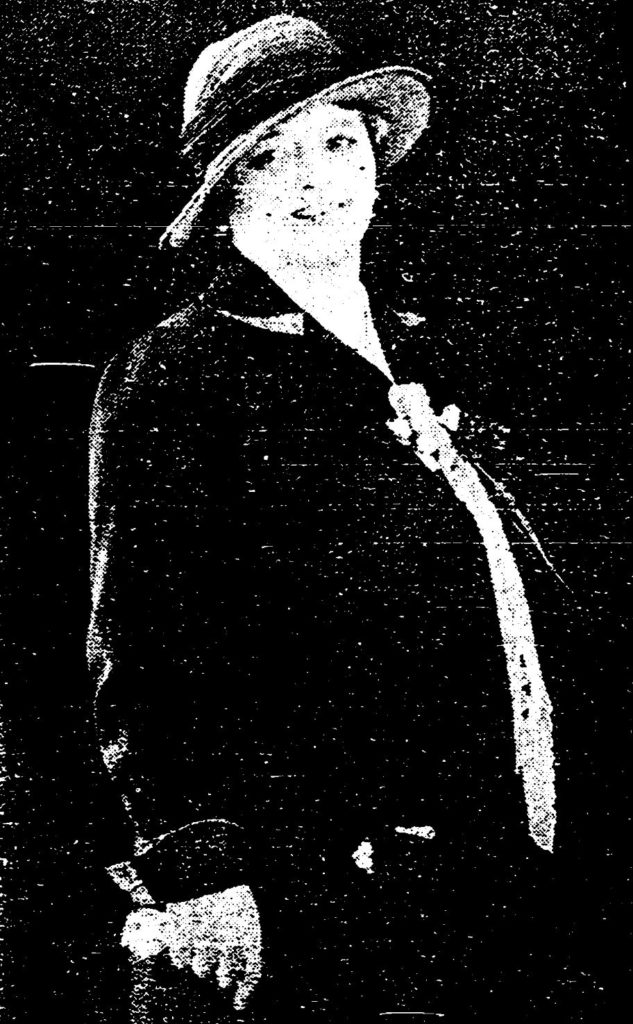The Tartts
One of the key factors that contributed to Beauvoir’s successful operations was the influence of the Tartt family. From 1916 through 1945, with the exception of only four years, Elnathan and Helen Tartt served as superintendent or assistant superintendent of the home. Their close supervision represented a New South bureaucratic efficiency that allowed for a constant level of care as well as key support from the state legislature and from the governor’s office.

Beauvoir Superintendents Elnathan and Helen Tartt, and their son Ned at Beauvoir. Either Elnathan or Helen Tartt served as superintendent of Beauvoir from 1916-1943 except for one four-year term from 1932-1936. Mississippi Gulf Coast Community College Beauvoir Collection.
Helen Tartt entered the role as assistant superintendent, to her husband Superintendent Elnathan Tartt, as early as 1916 (though she did not officially receive that title until 1920). In 1926, she accepted the governor’s appointment to run the home, a decade or more before it became common for white women to lead Confederate homes. Tartt reported to Beauvoir’s five-member all white board (which also included two women) and directly to Mississippi’s governor. They shared this role until 1928, when Elnathan Tartt resumed his role as superintendent and Helen as assistant superintendent. When political winds changed in the state in 1932, they were both replaced, but four years later, Helen Tartt resumed the leadership of Beauvoir, and she held the position of superintendent until her death in 1943.[1]
Throughout her leadership of the home, Helen Tartt managed large legislative appropriations and massive Depression-era cuts budgets with equal success. She directed the daily operations for as many as 250 residents and dozens of employees. She oversaw the physicians and hospital staff, the purchasing of food, livestock, and supplies, and managed all contract work for the property.[2] Her leadership came at a time of rising opportunity for white women in Mississippi. Women studied at institutions of higher education, entered the professional workforce, and assumed leadership roles at the state-funded women’s college, in the suffrage movement, in the arts and literature.[3]

On August 1, 1926, the New Orleans Times-Picayune featured Helen Tartt on its front-page coverage of leading white women in the region.
Helen Tartt’s early leadership may have been made possible by her husband’s success as a popular long-term superintendent, the experience she learned as assistant-superintendent to Elnathan, and his political connections to Governor Theodore Bilbo. Still, Helen gained recognition throughout the Gulf South, in her own right, for her advocacy of Beauvoir residents and the efficiency with which she ran the home.[4] The New Orleans Time-Picayune featured Tartt’s leadership of Beauvoir with a front-page article and photograph in 1926, insisting that it was a blend of her “good cheer, patience, housewifely and executive abilities” that “won for Mrs. Helen Tartt the only headship of a state institution in Mississippi.” The editor noted Elnathan’s prominence, but concluded that the board selected Helen “because of her eminent ability to handle this extremely difficult job.”[5] The public recognized Helen Tartt’s organizational acumen, too, if only through their regular contact with her as a prominent, influential business woman. From the late 1920s through the early 1940s, local papers printed frequent notices calling for bids from grocers, dairy farmers, undertakers, and contractors for services needed at the home, and readers were instructed to contact “Mrs. Helen Tartt, Supt.” with their sealed bids. These notices served as regular reminders, year after year, that a New South woman directed Beauvoir’s large-scale and efficiently run operations.[6]
Helen Tartt died in her leadership role at Beauvoir in April 1943. Elnathan accepted the role of superintendent for a short before resigning from the position later that summer.[7]
This post is excerpted from the
article by Susannah J. Ural, “‘Every
Comfort, Freedom and Liberty’:
A Case Study of Mississippi’s Confederate Home,” The Journal of the Civil War Era 9
(March 2019), 55-83.
[1] New Orleans Times-Picayune, August 1, 1926; Biloxi Daily Herald, April 2, 1943.
[2] Twelfth Biennial Report of the Board of Directors, Jefferson Davis Beauvoir Memorial Home, 1926-1927. Beauvoir, Soldiers Home Reports, Folder 1, Jefferson Davis Presidential Library, Biloxi, Mississippi.
[3] Marjorie Julian Spruill, “Nellie Nugent Somerville: Mississippi Reformer, Suffragist, and Politicians,” Joanne Varner Hawks, “Belle Kearney: Mississippi Gentlewoman and Slaveholder’s Daughter,” and Sarah Wilkerson-Freeman, “Pauline Van de Graaf Orr,” in Mississippi Women: Their Histories, Their Lives, eds. Martha H. Swain, Elizabeth Anne Payne, Marjorie Julian Spruill (Athens: University of Georgia Press, 2010), 72.
[4] Praise for Elnathan Tartt, Helen Tartt, and the efficiency of the Jefferson Davis Soldiers’ Home appeared in dozens of papers from 1916 through the 1940s. Examples of this appear in the Daily Mississippi Clarion and Standard (Jackson, Mississippi), September 1, 1921; Biloxi Daily Herald (Biloxi, Mississippi), July 14, 1926; Greenwood Commonwealth (Greenwood, Mississippi), August 12, 1927; Indianola Enterprise (Indianola, Mississippi), September 29, 1927.
[5] New Orleans Times-Picayune, August 1, 1926.
[6] These ads appear regularly in the Biloxi Daily Herald from the late 1920s through the early 1940s. Specific examples can be found on May 14, 1927, July 3, 1936, and September 15, 1941. Thanks to Ward Calhoun, Carole Marshall, and Kathy Goss for their help in locating information on Helen Tartt.
[7] The Greenwood Commonwealth (Greenwood, Missisisppi), June 2, 1943.
